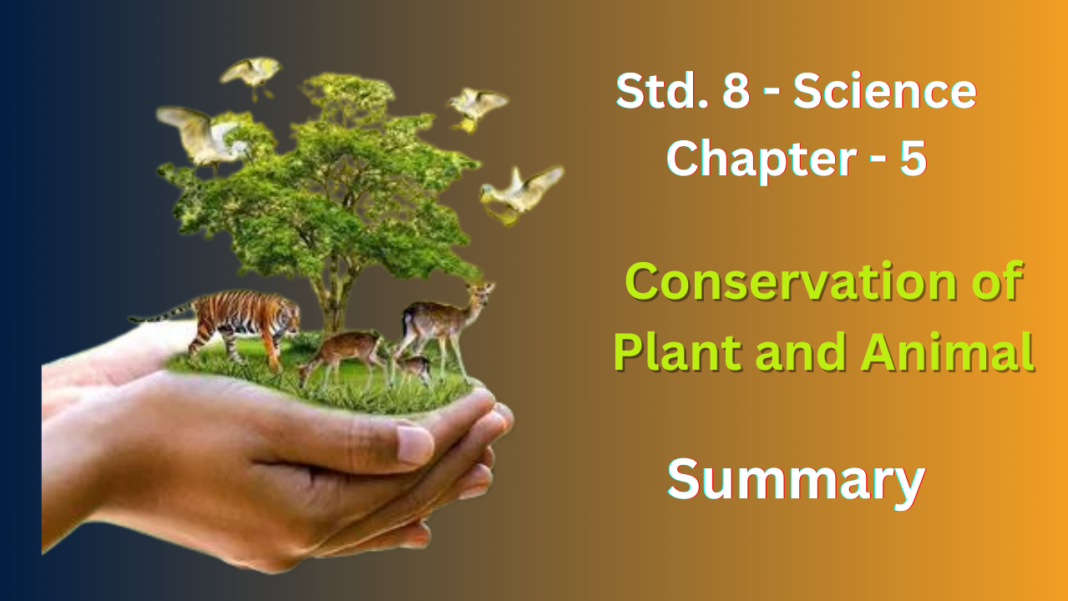NCERT Solutions for Class 8 Science Chapter 5
The chapter “Conservation of Plants and Animals” in your science curriculum focuses on the importance of protecting biodiversity and the various threats it faces. Here’s a summary:
- Biodiversity: This refers to the variety of life forms, including plants, animals, microorganisms, and their ecosystems. A healthy environment relies on this diversity.
- Importance of Conservation: Protecting plants and animals is crucial for maintaining ecological balance. They provide us with food, clean air and water, medicine, and other resources. They also play vital roles in pollination, seed dispersal, and soil fertility.
- Threats to Biodiversity: Human activities are the primary cause of threats to biodiversity. These include:
- Deforestation: Clearing forests for agriculture, industry, or housing destroys animal habitats and disrupts natural processes.
- Overexploitation: Excessive hunting, fishing, or resource extraction can lead to depletion of plant and animal populations.
- Pollution: Air, water, and soil pollution can harm plants and animals directly and disrupt ecosystems.
- Habitat Loss: Destruction or fragmentation of natural habitats due to urbanisation, development projects, or climate change leaves species with nowhere to live.
- Conservation Methods: Various strategies can help protect plants and animals:
- Protected Areas: Establishing national parks, wildlife sanctuaries, and bio reserves provides safe havens for endangered species and their habitats.
- Afforestation: Planting trees in degraded areas helps restore lost forests and create new habitats.
- Sustainable Practices: Sustainable harvesting of resources, reducing pollution, and adopting eco-friendly lifestyles are crucial.
- Captive Breeding Programs:** Breeding endangered species in controlled environments can help prevent extinction and reintroduce them to the wild when viable.
- Our Role: We can all contribute to conservation efforts by:
- Reducing our consumption and waste.
- Using resources sustainably.
- Supporting conservation organisations.
- Raising awareness about the importance of protecting biodiversity.
By understanding these concepts and taking action, we can help preserve the rich tapestry of life on Earth for future generations.
NCERT Solutions for Class 8 Science Chapter 5 Conservation of Plants and Animals
Q1.Fill in the blanks.
(a) A place where animals are protected in their natural habitat is called ______
(b) Species found only in a particular area is known as ______
(c) Migratory birds fly to faraway places because of ________ changes.
Ans:
- Wildlife sanctuary
- Endemic species
- Climatic
Q. 2 Differentiate between the following.
(a) Wildlife sanctuary and biosphere reserve
Ans: Wildlife sanctuaries and biosphere reserves both play a crucial role in protecting the environment..
- Wildlife Sanctuary: Primarily focuses on protecting wild animals, particularly endangered species, within their natural habitat. It offers them a safe space free from hunting, poaching, or habitat destruction.
- Biosphere Reserve: Aims for broader conservation. It encompasses a larger area that can include one or more wildlife sanctuaries along with other zones. Biosphere reserves aim to protect the entire ecosystem, including plants, animals, microorganisms, and their natural interactions
(b) . Zoo and wildlife sanctuary
Ans: differences between a zoo and a wildlife sanctuary:
- Zoo: Animals are kept in enclosures that attempt to replicate their natural habitat, but are ultimately artificial environments.
- Wildlife Sanctuary: Animals roam freely within a protected area of their natural habitat.
(c) Endangered and Extinct species
Ans: The main difference between endangered and extinct species lies in their population status and the possibility of recovery:
- Endangered Species: These are plant or animal species that are at risk of disappearing forever. Their populations are very small, declining rapidly, or facing serious threats from habitat loss, poaching, disease, or other factors. However, there’s still a chance to save them through conservation efforts like habitat protection, breeding programs, and reducing human impact.
- Extinct Species: These are species that no longer exist anywhere on Earth. They have completely vanished, and there’s no way to bring them back. Examples include the dinosaurs, the Tasmanian tiger, and the dodo bird.
(d) Flora and Fauna
Ans: Flora and fauna are both essential components of an ecosystem, but they represent different parts of that system:
- Flora: Refers to all plant life in a particular region or time period. This includes everything from towering trees and blooming wildflowers to microscopic algae and fungi.
- Fauna: Represents the animal life found in a specific region or during a specific period. It encompasses all animals, from insects and birds to mammals and reptiles.
Question 3.
Discuss the effects of deforestation on the following:
(a) Wild animals
(b) Environment
(c) Villages (Rural areas)
(d) Cities (Urban areas)
(e) Earth
(f) The next generation
Ans:
- Wild animals:
- Loss of habitat: Forests are homes to countless animals. Deforestation destroys their homes, forcing them to relocate or die.
- Disruption of the food chain: Forests are integral parts of the food chain. Deforestation disrupts the food web, impacting animal populations that depend on each other.
- Increased vulnerability: Deforestation exposes animals to predators and human activities they weren’t accustomed to.
(b)Environment:
- Soil erosion: Trees hold soil in place with their roots. Deforestation increases soil erosion, leading to loss of fertile land.
- Climate change: Forests absorb carbon dioxide, a greenhouse gas. Deforestation increases CO2 in the atmosphere, contributing to global warming.
(c) Villages (Rural areas):
- Reduced resources: Villages often rely on forests for resources like firewood, food, and medicine. Deforestation shrinks these resources.
- Increased soil infertility: Soil erosion from deforestation can impact agricultural productivity in nearby villages.
(d) Cities (Urban areas):
- Increased air pollution: Forests act as natural air filters. Deforestation can worsen air quality in cities.
- More extreme weather events: Deforestation can contribute to floods and dro
(e) Earth:
- Loss of biodiversity: Forests are hotspots of biodiversity. Deforestation leads to the extinction of plant and animal species.
- Disruption of ecological balance: Forests play a crucial role in maintaining the Earth’s ecological balance. Deforestation disrupts this balance.
- ughts, impacting cities as well.
(f) The next generation:
- Limited resources: Deforestation reduces the resources available for future generations, impacting their livelihoods and well-being.
- Worsened climate change: The effects of climate change due to deforestation will be felt more acutely by future generations.
Q4. What will happen if
- we go on cutting trees
- the habitat of an animal is disturbed.
- The top layer of soil is exposed.
Ans:
- We go on cutting trees (deforestation):
- Increased global warming: Trees absorb carbon dioxide, a greenhouse gas. Without them, more carbon dioxide traps heat in the atmosphere, warming the planet.
- Loss of fertile soil: Trees hold soil in place with their roots. Without trees, soil erosion increases, washing away the most fertile layer. This can lead to desertification.
- The habitat of an animal is disturbed:
- Animals lose food and shelter: When forests or other habitats are destroyed, animals can’t find the food and shelter they need to survive.
- Animals are forced to migrate: Animals may have to leave their homes in search of new habitats, which can be dangerous and stressful.
(c) The top layer of soil is exposed:
- Increased soil erosion: Wind and rain can easily wash away exposed soil, especially on slopes.
- Loss of nutrients: The top layer of soil is the most fertile, containing the nutrients plants need to grow. Erosion depletes these nutrients.
Q5. Answer in brief.
(a) Why should we conserve biodiversity?
Ans: We conserve biodiversity for a healthy planet: clean air, water, and resources, plus it’s the amazing variety of life on Earth!
(b) Protected forests are also not completely safe for wild animals. Why?
Ans: Protected forests aren’t completely safe because even though they offer protection, threats still exist inside:
- Poaching: People illegally hunt animals for their body parts or fur, putting them at risk.
- Resource use by nearby communities: People living near the forest might rely on it for resources, sometimes leading to conflicts with wildlife or habitat loss.
(c) Some tribals depend on the jungle. How?
Ans: Tribal communities living near jungles depend on them in several ways for their survival:
- Food: They gather fruits, nuts, berries, and even hunt animals for meat.
- Shelter: They use leaves, branches, and wood to build their homes.
- Medicine: Many jungle plants have medicinal properties used for treating illnesses.
- Materials: They use natural materials like bamboo, reeds, and fibres for making tools, utensils, and handicrafts.
(d) What are the causes and consequences of deforestation?
Ans: Causes of Deforestation:
- Agriculture: Clearing land for farms and ranches is a major driver of deforestation.
- Logging: Trees are cut down for timber used in construction, furniture, and paper production.
- Fuelwood: People in many regions rely on trees for firewood for cooking and heating.
- Infrastructure development: Building roads, dams, and mines often requires clearing forests.
Consequences of Deforestation:
- Loss of biodiversity: Forests are home to a vast number of species. Deforestation destroys habitats and disrupts food chains, leading to extinctions.
- Climate change: Trees absorb carbon dioxide, a greenhouse gas. Deforestation increases CO2 levels in the atmosphere, contributing to global warming.
- Soil erosion: Trees hold soil in place with their roots. Without trees, soil erosion increases, reducing fertility and leading to desertification.
(e) What is a Red Data Book?
Ans: The Red Data Book, also more commonly referred to as the IUCN Red List of Threatened Species, is not actually a single physical book anymore. It’s a digital inventory maintained by the International Union for Conservation of Nature (IUCN).
(f) What do you understand about the term migration?
Ans: Migration refers to the movement of animals from one place to another on a seasonal basis. This can be for a variety of reasons, such as finding food, water, or mates. For example, many birds migrate south for the winter in order to escape the cold weather.
Q6. In order to meet the ever-increasing demand in factories and for shelter, trees are being continually cut. Is it justified to cut trees for such projects? Discuss and prepare a brief report.
Ans: Cutting trees for building isn’t ideal. It hurts the environment but provides needed resources. We can find a middle ground through sustainable forestry, using alternative materials, and smart city planning. We need trees, but we need to be responsible about cutting them down.
Q7. How can you contribute to the maintenance of the green wealth of your locality? Make a list of actions to be taken by you.
Ans: You can help your local green spaces by:
- Planting trees or starting a container garden.
- Watering public plants and organising planting events.
- Spreading awareness and advocating for green policies.
- Reducing paper use, composting, and choosing sustainable products.
Q8. Explain how deforestation leads to reduced rainfall.
Ans: Trees are like rainmakers! They release moisture into the air, store water in the soil, and influence wind patterns. Cutting them down disrupts this cycle, leading to less rain.
Q9. Find out about national parks in your state. Identify and show their location on the outline map of India.
Ans: I understand you’re located in Pune, Maharashtra, India. Here are some national parks in Maharashtra:
- Tadoba Andhari Tiger Reserve (Chandrapur district) – This is the oldest and largest national park in Maharashtra, known for its tiger population.
- Sanjay Gandhi National Park (Mumbai) – A popular park near Mumbai with a variety of flora and fauna.
Q10. Why should paper be saved? Prepare a list of ways by which you can save paper.
Ans: Save paper, save trees! It fights climate change, saves resources, and even saves you money. Be digital, print double-sided, recycle, reuse, and rethink what you print!
Q11. Complete the word puzzle.
Down
1. Species on the verge of extinction.
2. A book carrying information about endangered species.
5. Consequence of deforestation.
Across
Ans:
- Endangered (species)
- Red Data Book
- Deforestation (consequence)
NCERT Solutions for Class 8 Science Chapter 5 Conservation of Plants and Animals
FAQ’s
What topics are covered in NCERT Solutions for Class 8 Science Chapter 5?
Chapter 5 Conservation of Plants and Animals focuses on the conservation of plant and animal resources. It discusses various aspects of conservation, including the importance of biodiversity, sustainable development, and measures to conserve natural resources.
How can NCERT Solutions for Class 8 Science Chapter 5 help in understanding conservation principles?
NCERT Solutions provide detailed explanations and examples that aid in understanding the concepts of conservation. By using these solutions, students can grasp the significance of conserving plant and animal resources and learn about the various methods and techniques used for conservation.
Are NCERT Solutions for Class 8 Science Chapter 5 Conservation of Plants and Animals available for free?
Yes, NCERT Solutions for Class 8 Science Chapter 5 Conservation of Plants and Animals, along with solutions for other chapters, are available for free on Education85. Students can access these solutions online to enhance their understanding of conservation principles and excel in their studies.
How do NCERT Solutions for Class 8 Science Chapter 5 contribute to environmental awareness?
By providing in-depth explanations and examples related to conservation, NCERT Solutions for Chapter 5 Conservation of Plants and Animals help raise awareness about environmental issues and the importance of preserving plant and animal species.
Can NCERT Solutions for Class 8 Science Chapter 5 be used for exam preparation?
Yes, NCERT Solutions for Chapter 5 Conservation of Plants and Animals are designed to help students prepare for their exams effectively. The solutions cover all the important topics and concepts in the chapter, ensuring thorough preparation and better performance in exams.









